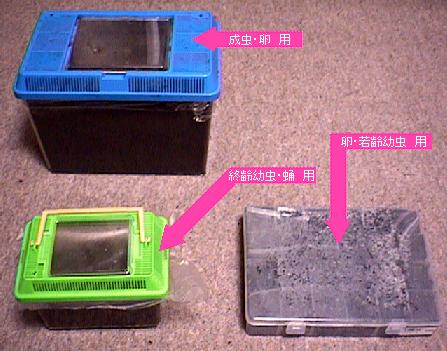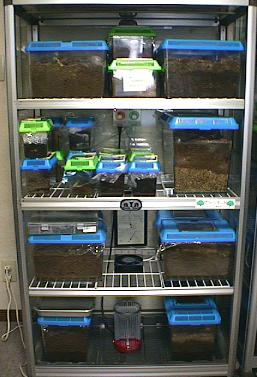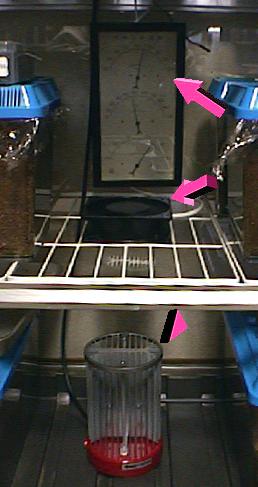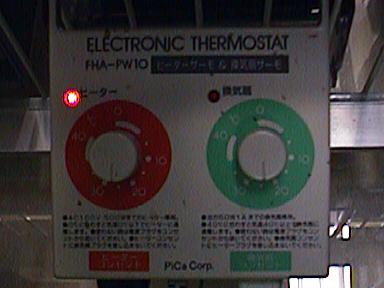 Preparation for rearing 1.
Preparation for rearing 1.Purchase a compost of broad leaves at a DIY shop or large supermarket.
I recommend the brand in the picture as it happens to have the smallest mixture of needle leaves.
This bag was 580 yen for 20 liters.
I wonder why the packaging for leaf compost is done in this very traditional Japanese style.
I get the feeling the golden printing is supposed to promote "enhanced results!"
 Preparation for rearing 2.
Preparation for rearing 2.Wood flakes can also be purchased in DIY shops and large supermarkets in Japan. The quality (fineness, etc.) differs with each lot and each manufacturer. As the price may differ as well, it is a good idea to check at several stores for comparison. The one in this picture was 300 yen for 4.5 liters. A middle-aged man gazing at these at DIY shops would look awfully strange. But I wouldn't worry. If you are very timid, and afraid to attract such attention, you might as well purchase already fermented wood flakes in bulk from mail order shops. You can find ads for these insect shops, in the pages of Monthly Mushi (insect) magazine or in Aquarium magazine. Most of them, I don't know why, tell you first to send them postage stamps in order to get their price list. Maybe a countermeasure against "window shoppers". Some shops then send you a xeroxed price list, just once, while others keep sending you new lists every time they renew the prices. I sympathize with those shops trying to survive in a limited market. I hope they all do well, so as to provide us with stable supplies. They may create more demand in the market!
 Preparation for rearing 3.
Preparation for rearing 3.Dry the leaf compost under sunlight, until it becomes crispy. Then sift out small stones. You might break your food processor if you omit this procedure. I broke 3 of those machines in 2 years, because I was lazy.
 Preparation for rearing 4.
Preparation for rearing 4.I bought this food processor for 3,980 yen at a DIY. I use this to get the mixed powder of leaf compost and flakes. I added 4.5 liters of wood flakes to 20 liters of leaf compost to get the right substrate for egg laying. It takes almost one entire day to prepare enough powder mat for a medium-sized plastic container. As the food processor can easily break down with continuous use, because of the heat, I take regular breaks to cool it down. What I expect from this fine powder mat is to improve the survival rate of the hatchlings and to secure enough moisture. All the time and affection I spend make me feel at least that more eggs will turn into imagoes in the end.
 Preparation for rearing 5.
Preparation for rearing 5.There is also a manual tool like this for those who hesitate to purchase expensive electric food processors. I bought this one for 980 yen. All you need is stamina, as it is manual. When you use this one, there is only a little risk of breakage, even if there are some stones in the mixture as the revolution rate is low. But it is really tiring. Huh...
 Preparation for rearing 6.
Preparation for rearing 6.This is the atomizer for spraying water over the mat for moisture. At first, I used small ones made for ironing. I broke 4 of those in 2 years. So I bought this robust atomizer used for pesticide spraying. I think it was 3980 yen at a supermarket. I think it is more cost-effective to buy this one in the first place before you break many cheap ones. As it contains 4 liters, you don't have to run around too often supplying water. Even if you give up on the stag beetle rearing hobby eventually, you can enjoy it as a water pistol. If your kids attack you with their water pistols in summer, fight back with this water M60. Maybe they'll rip it out of your hands to fight back. Hmmm, I can imagine your wife yelling at you and the brats. Well, maybe we'd better stay away from such stupid scenarios.
 Preparation for rearing 7.
Preparation for rearing 7.This is a commonly sold spoon designated for eating crabs. I think it was about 400 yen. I use it to retrieve eggs and young hatchlings. It can be used to crack and browse through the mat, too. You can lower the death rate (accidents in which you kill the larvae) by using this spoon. If you use a large spoon, it may directly hit the larva and kill it, as you don't know where in the mat the larva resides. I often use a bamboo skewer made for yakitori. I let the larva that tries to hide in the mat bite it, so that I can pull it out. Also, when the mat is glued to the plastic container and doesn't fall off, even if you turn the container upside down, you can stick this skewer between the mat and the wall of the container to make room. Then you can easily separate it by hitting on the bottom of the container.
 Preparation for rearing 8.
Preparation for rearing 8.I change their living environment three times while the egg hatches and finally grows into an imago. I purchase large rearing cases, small rearing cases, and lure cases (or similar partitioned/pill cases) at a supermarket or DIY. I especially need a large number of small cases for 3rd instar larvae and pupae. If you succeed in breeding, one pair can reproduce almost 30 larvae. Large cases and lure cases are about 1,000 yen each. The small case is about 300 yen. I personally buy these in dozens by mail order. In that case, it can be as cheap as 150 yen a piece.
 Preparation for rearing 9.
Preparation for rearing 9.A greenhouse is not indispensable. But as I wanted them to grow faster, I used it. You can control the ecdysis cycle by using a greenhouse. Greenhouses can be obtained at the gardening corner of DIY shops. At the end of the season, they often go on sale. So it is a good idea to check the price every once in a while. The price is something between 20,000 and 30,000 yen. Pica and Alinco are two of the best-known manufacturers.


Preparation for rearing 10.
Then you prepare some more necessary items in the greenhouse. A typical combination of thermostat and heater should be 10,000 to 20,000 yen. You had better have a large thermometer so that you can easily watch and check the temperature. In order to make the temperature in the greenhouse uniform, you might as well buy an electric fan/circulator if your budget allows. Although the thermostat is supposed to turn on the heater when the temperature falls down to the preset level, it's accuracy is not too reliable, I have often experienced the temperature rising over 30 when I preset it for 25 degrees. The electric fan will help make the temperature in the greenhouse uniform. I bought the fan of some anonymous manufacturer in Akihabara for 1,500 yen and am using it. As for the thermostat, an electronic thermostat is more reliable than the bimetal one that usually comes with the heater. So I recommend you buy the electronic type if possible. The one in the picture is electronic and it's about 10,000 yen.
 Preparation for rearing 11.
Preparation for rearing 11.The use of a heater creates excessive dryness in the environment. I bought an aluminum tray for about 1,000 yen and I fill it with water.